Intel Dual-Core Mobile Ivy Bridge Launch and i5-3427U Ultrabook Review
by Jarred Walton on May 31, 2012 12:01 AM EST- Posted in
- Laptops
- CPUs
- Intel
- Ivy Bridge
- Ultrabook
Ivy Bridge Ultrabook Quick Sync and 3DMark Performance
Buying a laptop isn’t just about generic office and Internet applications, naturally. Intel (and AMD and NVIDIA) have been pushing video and image processing applications as increasingly important, in our digital Facebook/YouTube/etc. world. We’ve looked at two video transcoding applications from ArcSoft and CyberLink several times already, but let’s see how Ivy Bridge Ultrabooks rate. We’ve run a video transcode converting a 3:43 minute 1080p24 video clip taken with a Nikon D3100 camera into a 720p video and timed how long the process takes.
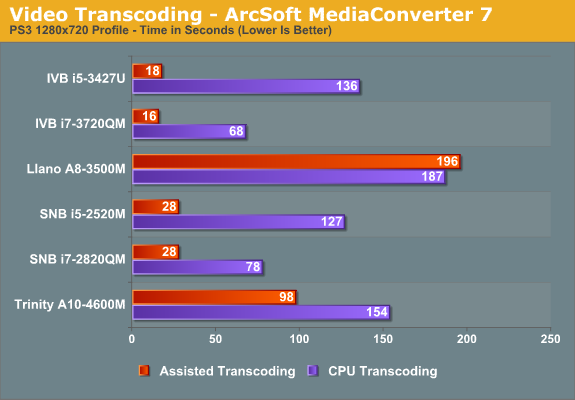
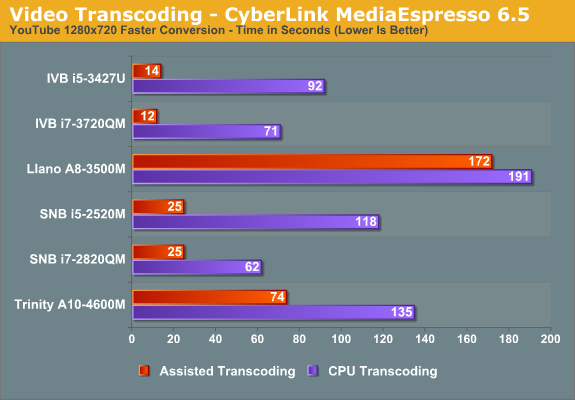
Quick Sync continues to be the undisputed champion of these two applications, beating out AMD’s accelerated transcode on Trinity by a factor of five. However, if you’re really into video transcoding and you want more control over quality, we don’t know many people who use MediaEspresso or MediaConverter. For free software, Handbrake is probably the most popular option right now, and as we showed previously, AMD has a beta OpenCL accelerated version of Handbrake that they’ve been working on where they can come very close to quad-core Ivy Bridge performance.
It remains to be seen when the public release of Handbrake will get such support, not to mention Intel and NVIDIA are going to be interested in getting the OpenCL version to run appropriately on their hardware. Still, it’s important to keep these other developments in mind. For now, the best quality transcodes still come by way of the CPU, and ULV Ivy Bridge offers better performance than AMD’s Trinity A10 in that case—never mind the standard voltage parts. We expect to see additional software companies start looking at ways to leverage OpenCL, GPUs, APUs, and Quick Sync to help with this sort of workload going forward.
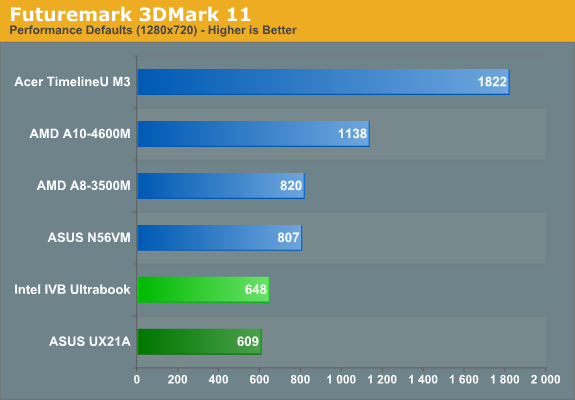
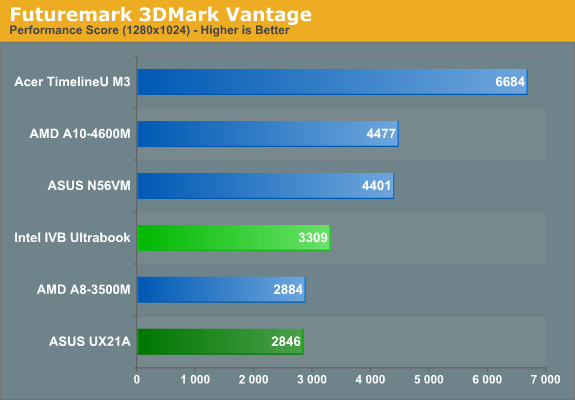
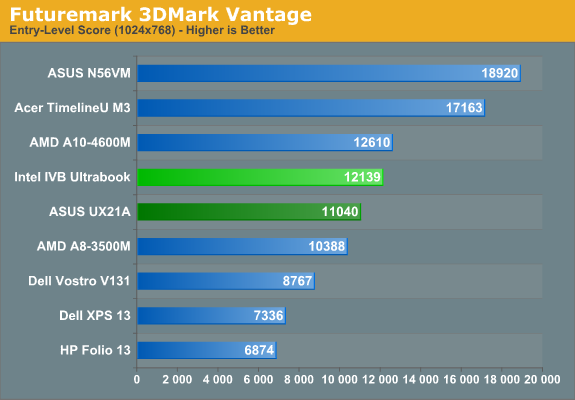
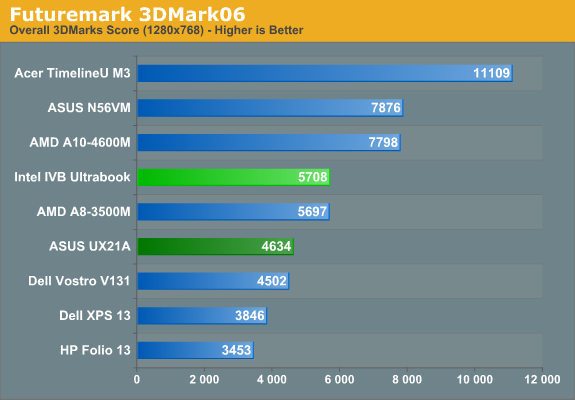
As for synthetic graphics performance, Intel has performed quite well in 3DMarks for several years now—we’d argue their 3DMark scores are often optimized far more than actual gaming performance. Still, 3DMarks are a nice way to compare across several generations of hardware, so we continue to run them on laptops. Again we see the UX21A trail the IVB ULV prototype, despite having a higher performance i7 CPU; thermal issues are the most likely cause, and the difference ranges from a rather minor 6% gap in 3DMark11 up to 23% in 3DMark06. Also interesting is that the quad-core i7-3720QM, which has a GPU that’s only clocked up to 9% higher, ends up leading the ULV IVB part by 25% (3DMark11) to as much as 33% or more! The extra—and faster—CPU cores might be a factor, but it’s also likely that the i7-3720QM is able to hit the maximum 1250MHz GPU clock far more often than the i5-3427U can hit its maximum 1150MHz clock.
Once we get beyond the Intel IGP comparisons, however, things don’t look nearly as good for ULV Ivy Bridge. Llano is around 25% faster in 3DMark11, though ULV IVB comes out ahead in the other results; Trinity on the other hand is 35-75% faster in the three main results (e.g. not counting 3DMark Vantage Entry, as that’s very low in terms of stressing the GPU). Again, the most interesting comparison is unfortunately one we can’t make yet: how will the A10-4655M 25W Trinity APU (with GPU clocks that are almost 30% lower than the 35W A10) compare with ULV IVB? We’ll have to take a wait and see approach on that one, but depending on the game it may or may not be a close matchup.










64 Comments
View All Comments
marioyohanes - Thursday, May 31, 2012 - link
Intel should learn from Apple users for the keyboard design... We all know how much Apple users hate white keyboard in previous MacBook models, that's why Apple is using black keyboard now...JarredWalton - Thursday, May 31, 2012 - link
Hahaha... I realized I never took a picture of the open laptop and so I used the image Intel sent along. I'll post an updated picture to the article in a moment, but suffice it to say that the review sample doesn't have a white keyboard.marioyohanes - Thursday, May 31, 2012 - link
I love the keyboard design on your new pic... :)kamalppc - Tuesday, January 29, 2013 - link
You can find the reviews here -http://cpudistro.com/intel/core-i5-3427u/
http://ultra-book.co/core-i5-3427u-review/
mcquade181 - Thursday, May 31, 2012 - link
I guess Apple users must value asthetics over funtionality!From a useablity point of view black keyboards are horrible.
In low light conditions it is very difficult to see individual keys, which, unless you can touch type, makes them very hard to use.
I suspect that's why there is so much desire for backlit keyboards.
Concillian - Sunday, June 3, 2012 - link
We should make keyboards for people who can't touch type?This is 2012 dude, if you can't touch type you have a problem. Everything you do in the business world and half the things in todays social world require using a keyboard of some kind as an input.
Catering hardware (and software) to the people who can't use them right ends up hindering productivity for those who are actually productive on their computer.
Argedut - Sunday, June 10, 2012 - link
You're totally right. Also if you don't understand the dewey decimal system don't even BOTHER looking for a job. Am I right?iwod - Thursday, May 31, 2012 - link
I am amazed by the Chipset TDP and die size, But as transistor shrinks but I/O lanes remain constant, may be we could further include things inside the chipset? Things like an SSD Controller? Or few years down the road there will be no more Chipset, just a SoC.Shadowmaster625 - Thursday, May 31, 2012 - link
The SSD controller should be right on the CPU die right next to the memory controller. But I guess Intel doesnt mind getting totally devoured by Apple, who was actually smart enough to make a chip with a flash controller. Granted its not a very fast one, but at least it is there.There is no reason why every new computer should not have at least 32GB of flash that reads just as fast as DRAM, and with DRAM caching, would basically write just as fast too. With the controller in the cpu it lowers the cost of 32GB to just a few dollars.... the current spot price of four 8Gbitx8 MLC NAND chips is just $18. With a good integrated flash controller, the lower latencies on random reads could bring the real world random read speeds well past even a Vertex 4.
ZeDestructor - Thursday, May 31, 2012 - link
What exactly is the difference between the QS77 and the QM77? As far as I can see, there's no reason to use the QM77 at all since the QS77 has a better TDP and power usage than the QM77 while retaining all the features...